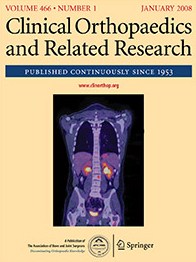
HAND & WRIST
Effect of brachial plexus blockade vs. general anaesthesia in DRF fixation
This report has been verified
by one or more authors of the
original publication.
Clin Orthop Relat Res. 2016 May;474(5):1247-54
36 patients with closed, displaced, and unstable distal radius fracture were randomized to receive either general anaesthesia or brachial plexus blockade. The purpose of this study was to compare pain scores and analgesic consumption at 2, 4, 6, 12, 24, 48 and 72 postoperative hours. Operative time was also recorded. Follow-up was scheduled for 2, 6, and 12 weeks postoperatively to assess, narcotic use, pain scores, and functional assessment scores. Findings indicated significantly greater immediate pain in the general anaesthesia group at 2 postoperative hours compared to the brachial plexus blockade group. In contrast, the results at 12 and 24 postoperative hours demonstrated significantly lower pain in the general anaesthesia group. Recovery duration in the postanaesthesia care unit (PACU) and opioid consumption (fentanyl & morphine) were greater in the general anaesthesia group compared to the brachial plexus blockade group. No significant differences were found between groups for operative suite time or functional assessment scores at 6 or 12 postoperative weeks.
Unlock the full ACE Report
You have access to {0} free articles per month.Click below to unlock and view this {1}
Unlock NowCritical appraisals of the latest, high-impact randomized controlled trials and systematic reviews in orthopaedics
Access to OrthoEvidence podcast content, including collaborations with the Journal of Bone and Joint Surgery, interviews with internationally recognized surgeons, and roundtable discussions on orthopaedic news and topics
Subscription to The Pulse, a twice-weekly evidence-based newsletter designed to help you make better clinical decisions
Exclusive access to original content articles, including in-house systematic reviews, and articles on health research methods and hot orthopaedic topics
Or upgrade today and gain access to all OrthoEvidence content for just $1.99 per week.
Already have an account? Log in


Subscribe to "The Pulse"
Evidence-Based Orthopaedics direct to your inbox.
{0} of {1} free articles
Become an OrthoEvidence Premium Member. Expand your perspective with high-quality evidence.
Upgrade Now













































































